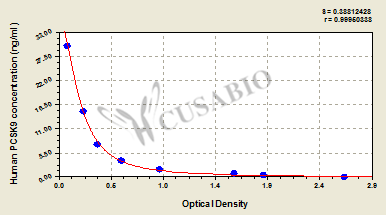This human PCSK9 ELISA kit employs the quantitative competitive enzyme immunoassay technique to measure the levels of human PCSK9 in different samples, including serum, plasma, or tissue homogenates. The enzyme-substrate chromogenic reaction is also used to amplify the signal and quantify the levels of the analyte through the intensity of the colored product. The color intensity negatively correlates with the amount of PCSK9 bound in the initial step.
PCSK9 is a serine protease that acts as a ligand for the low-density lipoprotein (LDL) and is a master participant in cholesterol homeostasis. PCSK9 upregulates LDL-cholesterol levels by binding to the LDLR and promoting its lysosomal degradation. PCSK9/LDLR binding also induces lysosomal degradation inside the cells thus resulting in a reduced LDLRexpression on the cell membrane. It is an important drug target due to its crucial role in lipid metabolism. High levels of PCSK9 are linked to enhanced increased atherosclerosis progress independent of LDL levels. PCSK9 also exerts pleiotropic roles in promoting inflammation in atherosclerosis.






